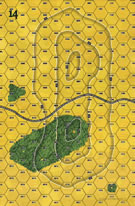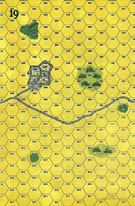|
Heroine of the Soviet Union Road to Berlin #57 |
||
|---|---|---|
| (Defender) Germany | vs | Soviet Union (Attacker) |
| Formations Involved | ||
|---|---|---|
| Germany |  |
309th "Berlin" Infantry Division |
| Soviet Union |  |
23rd Guards Rifle Division |

|
| Overall Rating, 1 vote |
|---|
|
3
|
| Scenario Rank: --- of 964 |
| Parent Game | Road to Berlin |
|---|---|
| Historicity | Historical |
| Date | 1945-04-16 |
| Start Time | 17:00 |
| Turn Count | 20 |
| Visibility | Day & Night |
| Counters | 111 |
| Net Morale | 1 |
| Net Initiative | 2 |
| Maps | 2: 14, 19 |
| Layout Dimensions | 56 x 43 cm 22 x 17 in |
| Play Bounty | 104 |
| AAR Bounty | 167 |
| Total Plays | 1 |
| Total AARs | 1 |
| Battle Types |
|---|
| Exit the Battle Area |
| Rural Assault |
| Conditions |
|---|
| Entrenchments |
| Off-board Artillery |
| Terrain Mods |
| Scenario Requirements & Playability | |
|---|---|
| Road to Berlin | Base Game |
| Introduction |
|---|
|
For its part of the final offensive, the 3rd Shock Army faced a heavily-fortified sector near the town of Letschin. When the 52nd Guards Rifle Division faltered, the 23rd Guards Rifle moved through its lines to resume the attack. The tough veterans recruited along Russia's Arctic coast stormed through the Nazi lines and ran into a heavily defended railroad embankment. Maj. Gen. P.M. Safarenko ordered his 63rd Guards Rifle Regiment to breach the line, but the commander of the lead company fell dead and the riflemen halted. "Is this woman's work?" screamed the company's female party organizer, Senior Sgt. L.S. Kravets. Pistol in hand, she started up the slope alone. The Guards followed. |
| Conclusion |
|---|
|
The Guards took heavy casualties, but topped the embankment and the German defense collapsed. "We were going to survive!" recalled German veteran Friedrich Schneck. "Where the order actually came from, no one could say. We got up and left that untenable position." Or to translate the euphemisms, the Germans dropped their weapons and fled in panic to the village of Sietzing, where the company cook rallied them and organized an ad-hoc defense. |
| AFV Rules Pertaining to this Scenario's Order of Battle |
|---|
|
| 2 Errata Items | |
|---|---|

|
The reduced direct fire value of the Heer HMG became 5-5 starting with Fall of France. (plloyd1010
on 2015 Jul 31)
|

|
Kommissars never get morale or combat modifiers. Ignore misprints. (Shad
on 2010 Dec 15)
|
| Little Alamoes on a Foggy Field | ||||||||||||
|---|---|---|---|---|---|---|---|---|---|---|---|---|
Knowing the overwhelming force that the Soviets were going to throw at them, the Germans abandoned any notion of defense in depth. Rather, they entrenched on the railroad embankment and waited. The German reserve consisted of two platoons posted behind the center of the position. Any other help would have to come, as the battle shaped up, from relatively unaffected areas of the line. The Germans planned to make use of the coming darkness to slip units further to the west, forcing the Soviets to play a deadly form of hide and seek. The Soviets decided to first hit the center of the line, making it hard for the Germans to determine which flank to reinforce from. These forces would begin to take German positions from center to right, and also stop the Germans from reinforcing. Once the engagement began, the rest of the Soviet force would move in on the far right and begin to roll up German positions from right to center. The first round of Soviet OBA took out an entrenched AT position and demoralized a GREN platoon. This effectively cut the badly stretched German line in two. It was also to be the last thing that went right for the Soviets. There were two factors that affected the outcome of this action: 1) Once engaged in combat, the Germans fought like lions. When assaults took place, the Germans would survive and disrupt and demoralize vastly superior Soviet numbers. The two platoons at the extreme left of the German line, through the calling in of OBA and direct fire, managed to stop the entire Soviet right dead in its tracks. 2) The Fog of War rolled in often and early. There were often times when there were only a handful of activations before the turn shut down. Assaults were prolonged and the many disrupted and demoralized units did not get a chance to rally. Every shutdown was help for the Germans and trouble for the Soviets. Had the battle been prolonged much longer, it would have gone easily to the Soviets. The Germans were simply running out of soldiers. However at the end of the action, the Soviets had not achieved their VC's. The Germans won, but there were precious few left to celebrate. If you're looking for a slam-bang engagement, where someone hollers "Charge" and lots of units go into a no-holds-barred battle, try this one. |
||||||||||||
| 0 Comments |

 RtBr056
RtBr056 




























